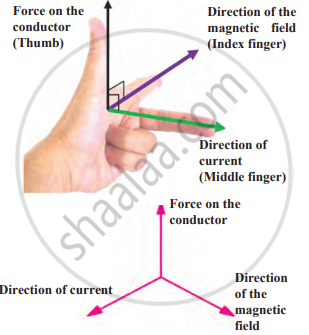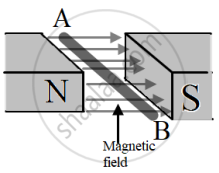Advertisements
Advertisements
प्रश्न
Name the following diagram and explain the concept behind it.

उत्तर
Fleming's left hand rule
It represents Fleming's left-hand rule used for finding the direction of magnetic force when a current-carrying conductor is placed in a magnetic field.

According to this rule, the left-hand thumb, index finger, and middle finger are stretched so as to be perpendicular to each other. If the index finger is in the direction of the magnetic field and the middle finger points in the direction of the current, then the direction of the thumb is the direction of the force on the conductor.
APPEARS IN
संबंधित प्रश्न
Consider a circular loop of wire lying in the plane of the table. Let the current pass through the loop clockwise. Apply the right-hand rule to find out the direction of the magnetic field inside and outside the loop.
The magnetic field in a given region is uniform. Draw a diagram to represent it.
State whether the following statement is true or false
The field at the centre of a long circular coil carrying current will be parallel straight lines.
When is the force experienced by a current-carrying conductor placed in a magnetic field largest?
State the rule to determine the direction of a force experienced by a current-carrying straight conductor placed in a magnetic field which is perpendicular to it.
Observe the following figure:

If the current in the coil A is changed, will some current be induced in the coil B? Explain.
What concealed do you get from the observation that a current-carrying wire deflects a compass needle placed near it?
Name the rule for finding the direction of magnetic field produced by a straight current-carrying conductor.
State the form of magnetic field lines around a straight current-carrying conductor.
Name any two factors on which the strength of magnetic field produced by a current-carrying solenoid depends. How does it depend on these factors?
List three ways in which the magnetic field strength of a current-carrying solenoid can be increased?
What type of core should be put inside a current-carrying solenoid to make an electromagnet?
The front face of a circular wire carrying current behaves like a north pole. The direction of current in this face of circular wire is:
(a) clockwise
(b) downwards
(c) anticlockwise
(d) upwards
What happens when a current-carrying conductor is placed in a magnetic field?
When is the force experienced by a current-carrying conductor placed in a magnetic field largest?
In a statement of Fleming's left-hand rule, what do the following represent?
(a) direction of centre finger.
(b) direction of forefinger.
(c) direction of thumb.
For Fleming's left-hand rule, write down the three things that are 90° to each other, and next to each one write down the finger or thumb that represents it.
The force exerted on a current-carrying wire placed in a magnetic field is zero when the angle between the wire and the direction of magnetic field is:
45°
60°
90°
180°
force experienced by a current-carrying straight conductor placed in a magnetic field which is perpendicular to it.
Two coils A and B of insulated wire are kept close to each other. Coil A is connected to a galvanometer while coil B is connected to a battery through a key. What would happen if:
the current is stopped by removing the plug from the key?
Explain your answer mentioning the name of the phenomenon involved.
Name three factors on which the magnitude of force on a current carrying conductor placed in a magnetic field depends and state how does the force depend on the factors stated by you.
Name and state the law which is used to determine the direction of force on a current carrying conductor placed in a magnetic field.
How will the direction of force be changed, if the current is reversed in the conductor placed in a magnetic field?
A flat coil ABCD is freely suspended between the pole of a U-shaped permanent magnet with the plane of coil parallel to the magnetic field.
When will coil come to rest?
A flat coil ABCD is freely suspended between the pole pieces of a U-shaped permanent magnet with the plane of coil parallel to the magnetic field.
When will the couple acting on the coil be
- maximum
- minimum?
The following diagram shows two parallel straight conductors carrying the same current. Copy the diagram and draw the pattern of the magnetic field lines around them showing their directions. What is the magnitude of the magnetic field at a point 'X' which is equidistant from the conductors? Give justification for your answer.

The shape of the magnetic field lines produced by a current-carrying conductor is ____________.
The direction of force on a current carrying conductor in a magnetic field is given by ____________.
The diagram below shows a free conductor AB is kept in a magnetic field and is carrying current from A to B. (To avoid confusion complete path of the circuit is not shown) The direction of the force experienced by the conductor will be:

Describe the activity that shows that a current-carrying conductor experiences a force perpendicular to its length and the external magnetic field. How does Fleming’s left-hand rule help us to find the direction of the force acting on the current carrying conductor?
What do you know about Michael Faraday?
Observe the given figure of Fleming's Left Hand Rule and write the labels of 'A' and 'B':

A copper wire is held between the poles of a magnet

The current in the wire can be reversed. The pole of the magnet can also be changed over. In how many of the four directions shown can the force act on the wire?
Which of the following pattern correctly describes the magnetic field around a long straight wire carrying current?
Two LED bulbs of 10W and 5W are connected in series. If the current flowing through 5W bulb is 0.005A, the current flowing through 10W bulb is ______.
If the strength of the current flowing through a wire is increased, the strength of the magnetic field produced by it ______.
A copper conductor is placed over two stretched copper wires whose ends ate connected to a D.C. supply as shown in the diagram.
- What should be the magnetic poles at the points A and B lying on either side of the conductor to experience the force in the upward direction?
- Name the law used to find these polarities.

